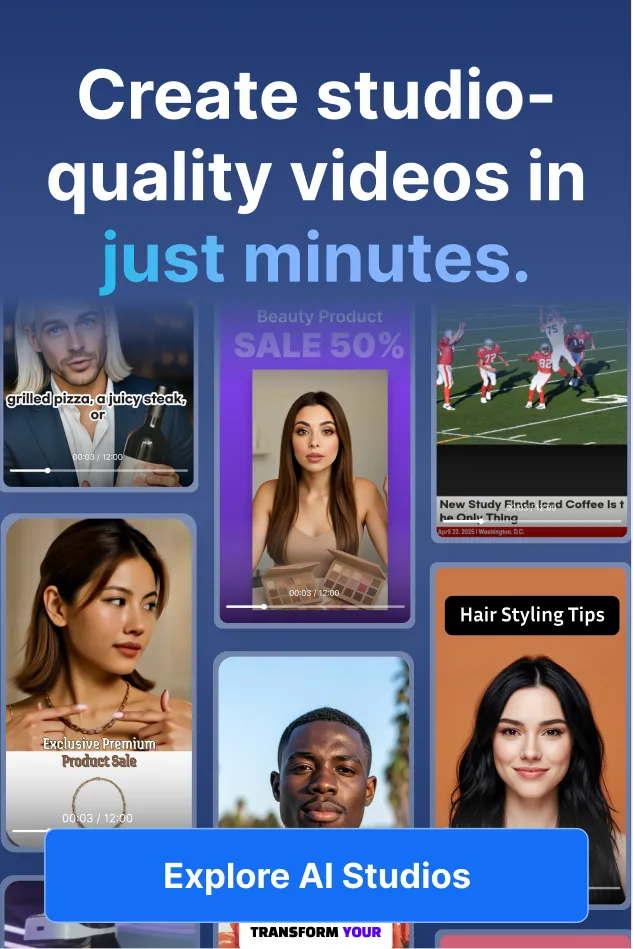❔How to Make PDFs Engaging?

Have you ever found yourself mindlessly scrolling through pages of a PDF, only to realize you've absorbed none of the content? What if I told you that the static, lifeless documents could leap off the page and into a dynamic, engaging video format? Yes, you read that right—your dusty old PDFs can now be transformed into captivating videos! But how, you ask? The answer lies in the latest innovation from DeepBrain AI: AI Studios 3.2. Imagine converting your reports, presentations, and guides into a format that not only holds your audience's attention but also communicates your message more effectively. The question is no longer "Can it be done?" but "How quickly can you jump on board?"
With an attention span that's shorter than that of a goldfish, as reported by a study from Microsoft, it's no wonder that videos have become the king of content. But what does this mean for your mountains of PDFs, those necessary evils in the world of information sharing? It means a revolution—a shift from the static to the cinematic. And DeepBrain AI's AI Studios 3.2 is at the forefront of this revolution. In this blog post, we'll unveil the magic behind the 'Docs to Video' feature, provide a step-by-step guide to transform your PDFs, and discuss how to navigate any potential hurdles. By the end of this article, you'll be equipped to not only understand the power of AI Studios but to use it to elevate your content to new, unforeseen heights. Are you ready to turn your documents into engaging, persuasive, and memorable videos? Let's dive in and explore the future of content consumption.
💁DeepBrain AI's AI Studios 3.2
In the ever-evolving realm of digital media, video content has emerged as an undisputed king, commanding the attention of audiences across various platforms. The demand for high-quality, engaging, and informative video content has never been greater, whether it's for marketing campaigns, educational tutorials, or pure entertainment. Recognizing this trend, DeepBrain AI has introduced AI Studios 3.2, a groundbreaking service poised to redefine the standards of video production. AI Studios 3.2 harnesses the most advanced artificial intelligence technologies to provide users with an unparalleled degree of customization, efficiency, and ease in crafting their video narratives.
AI Studios 3.2 is a leap forward in making sophisticated video creation more accessible. It eliminates the complexity often associated with professional video editing tools, thereby lowering the barrier to entry for content creators. This innovative platform is not just for seasoned videographers but is also tailored for beginners who wish to produce content that resonates with their audience. The essence of AI Studios 3.2 lies in its ability to democratize the art of video production, placing the power of AI-driven tools into the hands of creators who can now produce visually compelling and deeply engaging content with ease.
With AI Studios, users can take advantage of AI-driven features such as lifelike virtual anchors, automated voiceovers, and real-time video editing. This innovative approach to video creation is not just about adding a layer of technology; it's about enhancing the storytelling capabilities of creators, enabling them to produce dynamic video content that stands out in a crowded digital world.
📄New Feature: Docs to Video

DeepBrain AI's AI Studios 3.2 introduces the groundbreaking 'Doc to Video' feature, an innovative tool that effortlessly converts PDFs and other document files into captivating video content. This feature transcends the traditional boundaries of content creation by allowing users to transform static documents into dynamic, visually appealing videos. Whether it's a text document, an Excel spreadsheet, or a PDF, the 'Doc to Video' feature is designed to handle various file types with ease.
The process is remarkably simple and efficient. Users begin by uploading their document to the AI Studios platform. From there, they can customize options such as video length, template selection, and layout design. The AI then meticulously analyzes the content, generating a script for the AI presenter tailored to the document's message. The resulting video includes a fully functional script, a lifelike AI presenter, an engaging video background, and even background music—everything needed to create a polished and professional video.
The entire creation process takes a mere 5-10 minutes, and once the video is generated, users have the flexibility to further customize their project. This feature is particularly beneficial for businesses looking to convert reports, educational materials, or marketing content into a more digestible and engaging format. With 'Doc to Video,' DeepBrain AI's AI Studios 3.2 is redefining how we think about and interact with traditional documents, turning them into interactive experiences that capture and retain the attention of audiences in an innovative way.
🧗Step-by-Step Guide
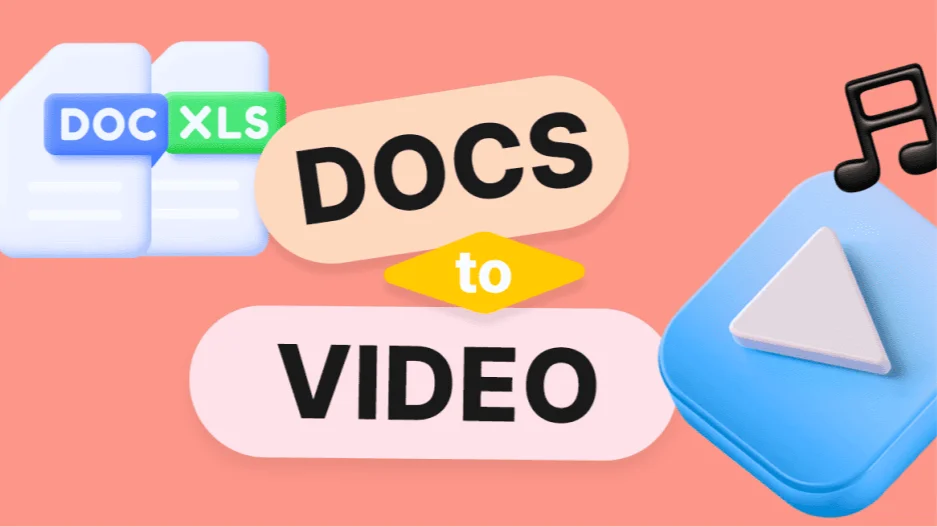
Transforming a PDF into a compelling video narrative is no longer a task reserved for professional video editors. DeepBrain AI's AI Studios 3.2 has revolutionized this process with its 'Doc to Video' feature, making it possible for anyone to create engaging video content from static documents. Here's a step-by-step guide to help you navigate this innovative feature and bring your documents to life.
Step 1: Prepare Your Document
Before you begin, ensure that your PDF or document file is ready for conversion. It should be well-structured and contain the content you want to showcase in your video. Keep in mind that clear, concise, and visually organized documents will translate into more effective video content.
Step 2: Access AI Studios 3.2
Navigate to DeepBrain AI's AI Studios 3.2 platform. If you're new to the service, you may need to create an account or log in. Once you're on the dashboard, locate the 'Doc to Video' feature to start the conversion process.
Step 3: Upload Your Document
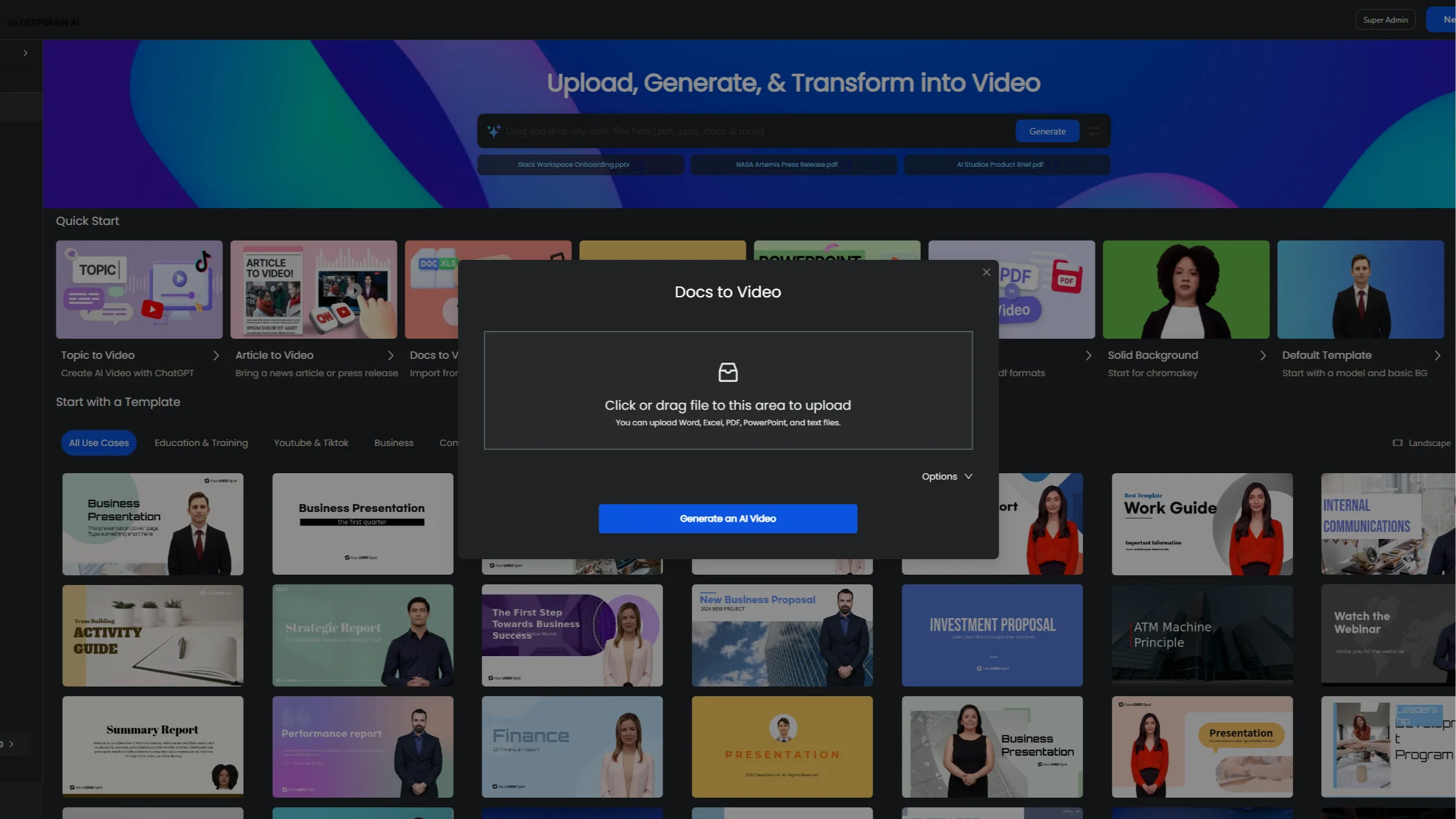
Click on the upload option and select the PDF or document file you wish to convert. The AI Studios 3.2 platform accepts various file types, including PDFs, text documents, and Excel spreadsheets. After uploading, the platform will analyze your document to prepare it for the next stage.
Step 4: Customize Your Video Settings
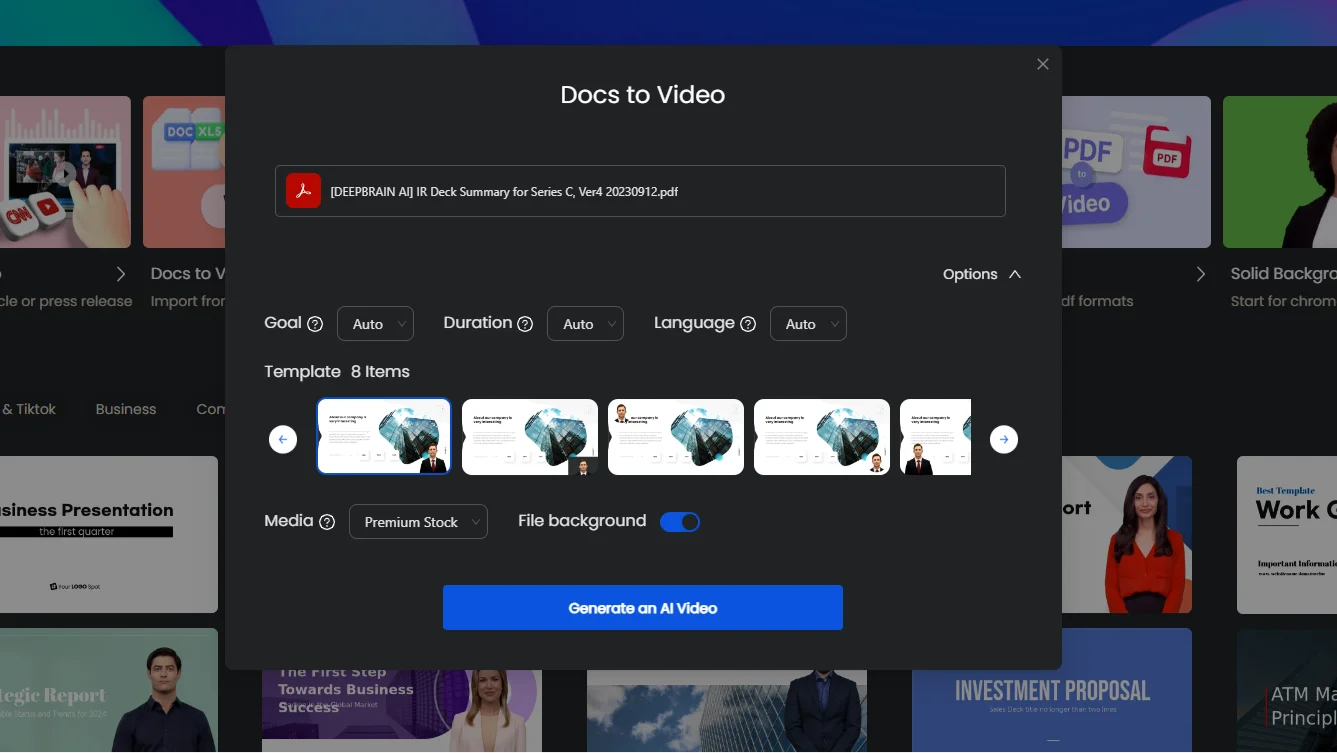
After your document is uploaded, you will be prompted to customize your video. This includes selecting the desired video length, choosing a template that matches the style and tone of your content, and deciding on the layout design. These options allow you to tailor the video to your specific audience and message.
- Keep your audience in mind when customizing your video settings. A well-chosen template and thoughtful design can greatly enhance the viewer's experience. Experiment with different settings to see which works best for your content and don't be afraid to try new styles to keep your videos fresh and engaging. Remember, the goal is to captivate and convey your message effectively!
Step 5: Script and AI Presenter Generation
The AI will then process the content of your document and generate a script that will be narrated by a lifelike virtual AI presenter. This script is designed to convey the essence of your document in a clear and engaging manner. You'll have the opportunity to review and edit the script if necessary to ensure it aligns with your intended message.
Step 6: Finalize and Customize
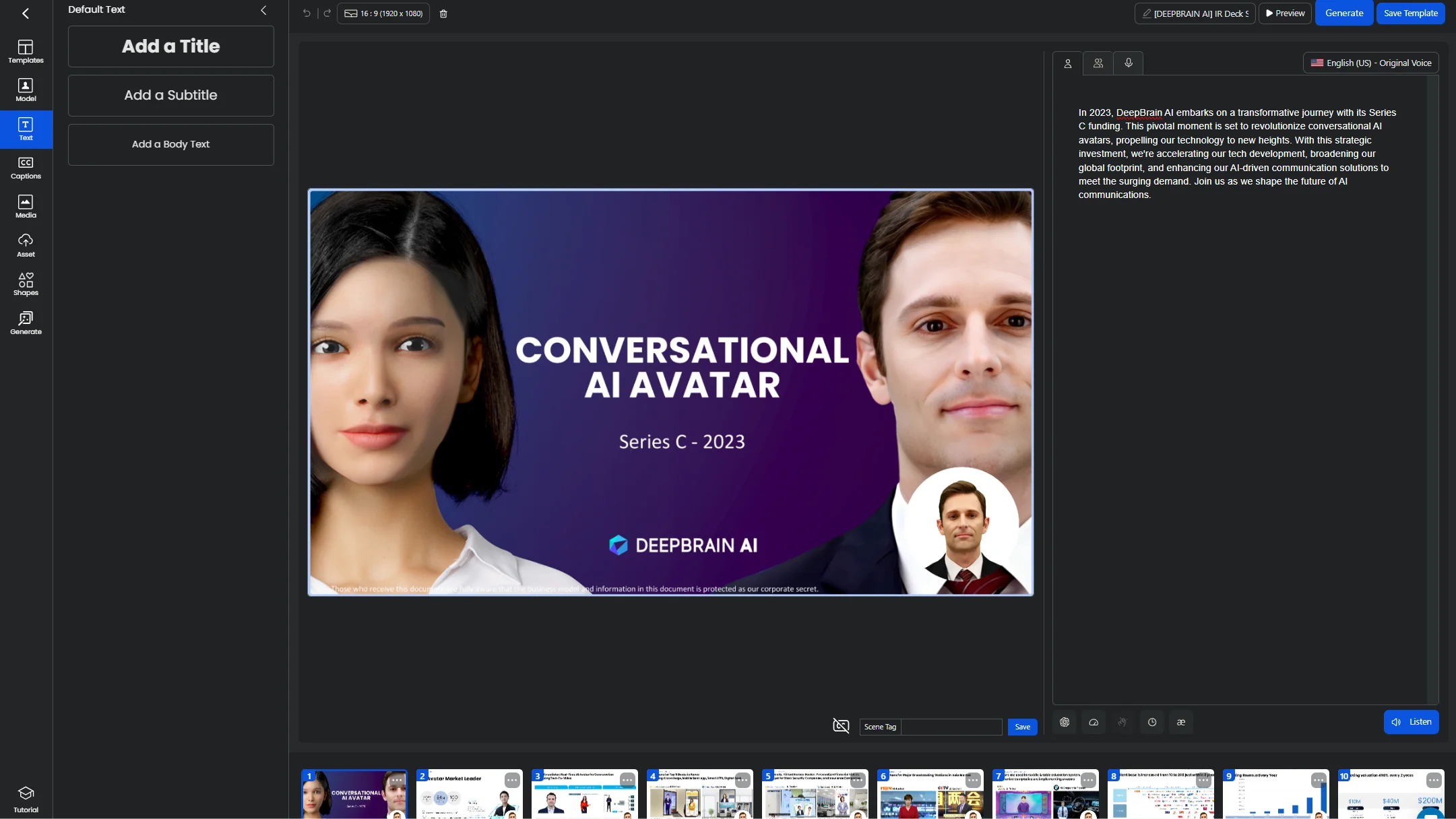
Once the script is finalized, the AI will create a video that includes the AI presenter, an appropriate video background, and even background music if desired. This draft video is a starting point, and you have the flexibility to make further customizations, such as adjusting the timings, adding visual elements, or changing the music.
- Don't be afraid to experiment with different video elements to make your content stand out. Adjusting the background, tweaking the music, and adding unique visual flairs can elevate your video from good to great. Your personal touches can make all the difference in engaging your audience!
Step 7: Review and Export
Before exporting your video, take the time to review it thoroughly to ensure that it meets your expectations. Look for any areas that may need tweaking, and use the platform's editing tools to make your video as polished and professional as possible. Once you're satisfied, export the video in your preferred format and resolution.
Step 8: Share Your Video
With your video now ready, it's time to share it with the world. You can upload it to various platforms, including social media, YouTube, or your company website. The engaging format of your new video is sure to capture the attention of your audience and deliver your content in an innovative and memorable way.
DeepBrain AI's AI Studios 3.2 'Doc to Video' feature is a game-changer for content creators, educators, and businesses alike. By following these simple steps, you can easily convert your static documents into dynamic and engaging video content that stands out in today's digital landscape.
🔍Innovative 'Doc to Video' Overview
The 'Doc to Video' feature from DeepBrain AI's AI Studios 3.2 is a groundbreaking tool that revolutionizes the way we create video content from text documents. It's designed to convert written content into engaging and professional-looking videos with ease. Below is a table that succinctly outlines the advantages and disadvantages of utilizing this innovative feature in your content creation process.
| Pros | Cons |
|---|---|
| Accessibility and Ease of Use | Limited Creative Control |
| Intuitive interface suitable for all skill levels. | Customization options may not meet all creative needs. |
| Time and Cost Efficiency | Potential for Over-Reliance on AI |
| Quick video generation saves time and resources. | Risk of content homogenization and loss of uniqueness. |
| Consistency and Scalability | Technological Barriers |
| Uniform quality and style for brand coherence. | Challenges for those with limited tech access or complex documents. |
Detailed Insights
- Accessibility and Ease of Use
DeepBrain AI has prioritized user experience with a straightforward and accessible interface. This feature empowers individuals and businesses, irrespective of their technical expertise, to create compelling video content. It's a step towards democratizing the video production process, making it an inclusive tool for all content creators.
- Time and Cost Efficiency
With the 'Doc to Video' feature, the once labor-intensive process of video creation is now significantly streamlined. Users can bypass the traditional hurdles of video production, such as hiring a professional team or investing in expensive equipment, thus enabling a more efficient content creation workflow.
- Consistency and Scalability
For entities aiming to establish a consistent brand image, this feature guarantees a standardized quality and style across all video content. It's also scalable, which is essential for businesses that need to produce a large volume of content within a tight timeframe.
Challenges to Consider
- Limited Creative Control
Creators who have a specific vision for their content may find the customization options provided by the AI to be somewhat restrictive. While the feature offers various editing capabilities, there may be instances where manual intervention is necessary to achieve the desired outcome.
- Potential for Over-Reliance on AI
As we embrace AI-driven content creation, there's a risk that the distinct human touch could be lost. Over-reliance on the AI's capabilities might lead to a landscape where videos lack the creative flair that only human editors can provide.
- Technological Barriers
Lastly, the feature's performance is contingent on the user's technological resources. Those without access to high-speed internet or advanced computing devices may not experience the full benefits of the 'Doc to Video' feature. Additionally, the quality of the input document is crucial; a well-structured source document is imperative for producing a high-quality video.
- In essence, DeepBrain AI’s 'Doc to Video' feature from AI Studios 3.2 presents a novel and efficient approach to video content creation, with its set of advantages that cater to the needs of diverse users. However, it's important to be aware of its limitations to ensure that the tool is used to its fullest potential, complementing rather than dictating your creative process.
✏️Navigating Potential Hurdles with AI Studios

Even with cutting-edge technology, creators may encounter some challenges. Here's how AI Studios can help you overcome them:
- Maintaining Visual Fidelity: To avoid any quality degradation, such as pixelation, start with a high-resolution PDF. AI Studios facilitates the maintenance of your document's original clarity throughout the video editing process.
- Managing File Size: Large PDFs can be cumbersome, potentially slowing down the conversion process. AI Studios offers efficient solutions, allowing you to divide your PDF into manageable sections without compromising on quality or performance.
- Ensuring Compatibility: The versatility of AI Studios extends to its support for numerous video formats. This ensures that your final video is ready to be viewed on any device or platform, eliminating compatibility concerns.
👍Elevating Your Video with AI Studios
To truly captivate your audience, consider these additional strategies:
- Engaging Narration: Utilize AI Studios' voice synthesis to add a professional voiceover, making your video not just more informative but also more relatable.
- Atmospheric Background Music: Set the mood and enhance viewer engagement with a carefully selected soundtrack. AI Studios' library of royalty-free music provides a wealth of options to underscore your video's message.
- Concise Content: In the digital age, attention spans are short. AI Studios helps you craft videos that are succinct yet impactful, ensuring your message is conveyed effectively without losing viewer interest.
📽️Can AI Turn Documents Into Engaging Videos?
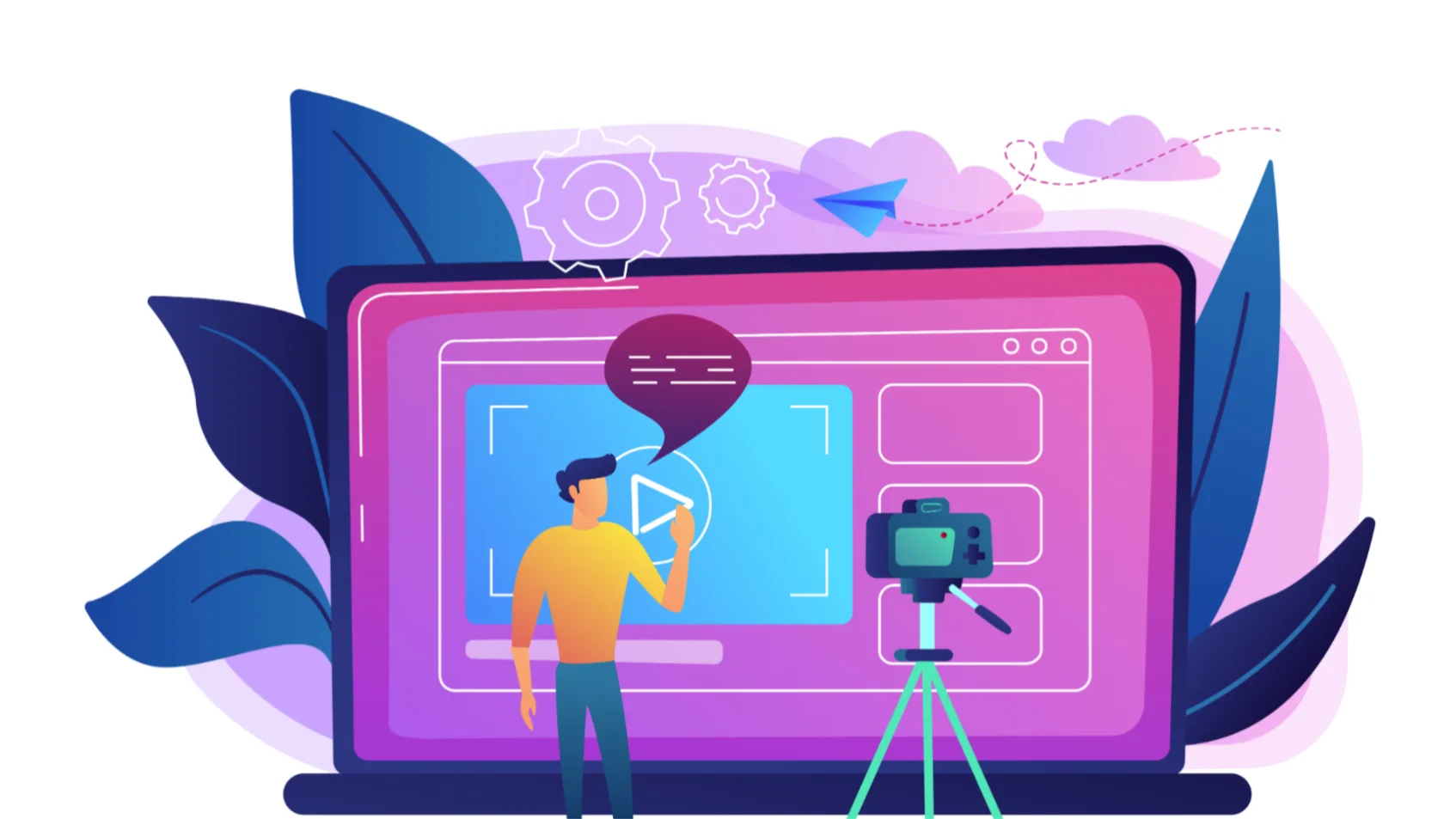
In the end, the 'Doc to Video' feature by DeepBrain AI's AI Studios 3.2 proved to be a game-changer for content creators of all kinds. The once mundane and static PDFs were transformed into vibrant and compelling videos that captivated audiences far and wide. Businesses saw an increase in engagement as their reports and marketing materials came alive, educators connected with students through dynamic tutorials, and individuals shared their stories in a format that was both accessible and exciting. The AI Studios 3.2 platform, with its intuitive design and powerful AI-driven tools, had indeed democratized video production, allowing anyone to become a storyteller in the digital age.
As creators continued to explore the depths of AI Studios 3.2's capabilities, they discovered that the 'Doc to Video' feature was not just about convenience and efficiency; it was about creativity and expression. The platform's ability to maintain the integrity of the original document while infusing it with the magic of video storytelling was unparalleled. It challenged the traditional notion of what it meant to create content, opening up a world of possibilities for those willing to embrace the power of AI in their creative endeavors. And as more and more people turned to AI Studios 3.2 to breathe life into their documents, the question on everyone's mind was clear: What other boundaries could AI help us break next?


